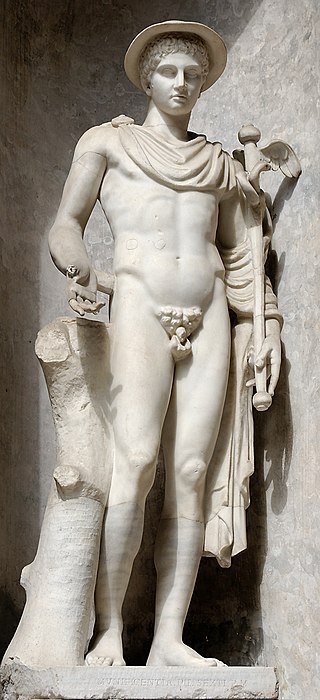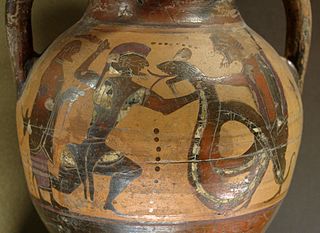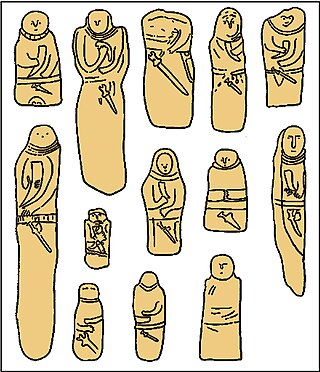Related Research Articles

Ares is the Greek god of war and courage. He is one of the Twelve Olympians, and the son of Zeus and Hera. The Greeks were ambivalent towards him. He embodies the physical valor necessary for success in war but can also personify sheer brutality and bloodlust, in contrast to his sister, the armored Athena, whose martial functions include military strategy and generalship. An association with Ares endows places, objects, and other deities with a savage, dangerous, or militarized quality.

Hades, in the ancient Greek religion and myth, is the god of the dead and the king of the underworld, with which his name became synonymous. Hades was the eldest son of Cronus and Rhea, although this also made him the last son to be regurgitated by his father. He and his brothers, Zeus and Poseidon, defeated their father's generation of gods, the Titans, and claimed rulership over the cosmos. Hades received the underworld, Zeus the sky, and Poseidon the sea, with the solid earth, long the province of Gaia, available to all three concurrently. In artistic depictions, Hades is typically portrayed holding a bident and wearing his helm with Cerberus, the three-headed guard dog of the underworld, standing to his side.

Hermes is an Olympian deity in ancient Greek religion and mythology. Hermes is considered the herald of the gods. He is also considered the protector of human heralds, travellers, thieves, merchants, and orators. He is able to move quickly and freely between the worlds of the mortal and the divine, aided by his winged sandals. Hermes plays the role of the psychopomp or "soul guide"—a conductor of souls into the afterlife.

In ancient Greek mythology and religion, Persephone, also called Kore or Cora, is the daughter of Zeus and Demeter. She became the queen of the underworld after her abduction by and marriage to her uncle Hades, the king of the underworld.

Dīs Pater, otherwise known as Rex Infernus or Pluto, is a Roman god of the underworld. Dis was originally associated with fertile agricultural land and mineral wealth, and since those minerals came from underground, he was later equated with the chthonic deities Pluto (Hades) and Orcus.

The Iguvine Tablets, also known as the Eugubian Tablets or Eugubine Tables, are a series of seven bronze tablets from ancient Iguvium, Italy, written in the ancient Italic language Umbrian. The earliest tablets, written in the native Umbrian alphabet, were probably produced in the 3rd century BC, and the latest, written in the Latin alphabet, from the 1st century BC. The tablets contain religious inscriptions that memorialize the acts and rites of the Atiedian Brethren, a group of 12 priests of Jupiter with important municipal functions at Iguvium. The religious structure present in the tablets resembles that of the early stage of Roman religion, reflecting the Roman archaic triad and the group of gods more strictly related to Jupiter. Discovered in a farmer's field near Scheggia in the year 1444, they are currently housed in the Civic Museum of the Palazzo dei Consoli in Gubbio.

Festivals in ancient Rome were a very important part in Roman religious life during both the Republican and Imperial eras, and one of the primary features of the Roman calendar. Feriae were either public (publicae) or private (privatae). State holidays were celebrated by the Roman people and received public funding. Games (ludi), such as the Ludi Apollinares, were not technically feriae, but the days on which they were celebrated were dies festi, holidays in the modern sense of days off work. Although feriae were paid for by the state, ludi were often funded by wealthy individuals. Feriae privatae were holidays celebrated in honor of private individuals or by families. This article deals only with public holidays, including rites celebrated by the state priests of Rome at temples, as well as celebrations by neighborhoods, families, and friends held simultaneously throughout Rome.

The word chthonic, or chthonian, is derived from the Ancient Greek word χθών, "khthon", meaning earth or soil. It translates more directly from χθόνιος or "in, under, or beneath the earth" which can be differentiated from Γῆ, or "ge", which speaks to the living surface of land on the earth. In Greek, chthonic is a descriptive word for things relating to the underworld and can be used in the context of chthonic gods, chthonic rituals, chthonic cults, and more. This is as compared to the more commonly referenced Olympic gods and their associated rites and cults. Olympic gods are understood to reference that which exists above the earth, particularly in the sky. Gods that are related to agriculture are also considered to have chthonic associations as planting and growing takes place in part under the earth.

The Floralia was a festival in ancient Roman religious practice in honor of the goddess Flora, held April 27 during the Republican era, or April 28 in the Julian calendar. The festival included Ludi Florae, the "Games of Flora", which lasted for six days under the empire.

In ancient Greek religion and mythology, the twelve Olympians are the major deities of the Greek pantheon, commonly considered to be Zeus, Poseidon, Hera, Demeter, Aphrodite, Athena, Artemis, Apollo, Ares, Hephaestus, Hermes, and either Hestia or Dionysus. They were called Olympians because, according to tradition, they resided on Mount Olympus.

Maia, in ancient Greek religion and mythology, is one of the Pleiades and the mother of Hermes, one of the major Greek gods, by Zeus, the king of Olympus.

Hittite mythology and Hittite religion were the religious beliefs and practices of the Hittites, who created an empire centered in what is now Turkey from c. 1600–1180 BC.

The Scythian religion refers to the mythology, ritual practices and beliefs of the Scythian cultures, a collection of closely related ancient Iranian peoples who inhabited Central Asia and the Pontic–Caspian steppe in Eastern Europe throughout Classical Antiquity, spoke the Scythian language, and which included the Scythians proper, the Cimmerians, the Sarmatians, the Alans, the Sindi, the Massagetae and the Saka.
In Ancient Greek Religion and mythology, Enodia is a distinctly Thessalian Ancient Greek goddess, identified in certain areas or by certain ancient writers with Artemis, Hecate or Persephone. She was paired with Zeus in cult and sometimes shared sanctuaries with him. Enodia was primarily worshipped in Ancient Thessaly and was well known in Hellenistic Macedonia.

A funerary cult is a body of religious teaching and practice centered on the veneration of the dead, in which the living are thought to be able to confer benefits on the dead in the afterlife or to appease their otherwise wrathful ghosts. Rituals were carried on for the benefit of the dead, either by their relatives or by a class of priests appointed and paid to perform the rites. These rituals took place at the tombs of the dead themselves or at mortuary temples appointed to this purpose. Funerary cults are found in a wide variety of cultures.

The di inferi or dii inferi were a shadowy collective of ancient Roman deities associated with death and the underworld. The epithet inferi is also given to the mysterious Manes, a collective of ancestral spirits. The most likely origin of the word Manes is from manus or manis, meaning "good" or "kindly," which was a euphemistic way to speak of the inferi so as to avert their potential to harm or cause fear.

In ancient Roman religion, the October Horse was an animal sacrifice to Mars carried out on October 15, coinciding with the end of the agricultural and military campaigning season. The rite took place during one of three horse-racing festivals held in honor of Mars, the others being the two Equirria on February 27 and March 14.

The supplicia canum was an annual sacrifice of ancient Roman religion in which live dogs were suspended from a furca ("fork") or cross (crux) and paraded. It appears on none of the extant Roman calendars, but a late source places it on August 3 (III Non. Aug.).
References
Notes
Citations
- 1 2 Dutch Archaeological and Historical Society 1977, p. 131.
- 1 2 Turcan & Nevill 2001, pp. 63–64.
- ↑ Elsner & Rutherford 2007, p. 24.
- ↑ Scullard 1981, p. 72.
- ↑ Frazer 2012, p. 190.
- ↑ Poultney, J.W. "Bronze Tables of Iguvium" 1959 p. 214 https://archive.org/details/bronzetablesofig00poul/page/n19/mode/2up
Books
- Elsner, Jas'; Rutherford, Ian (2007). Pilgrimage in Graeco-Roman and Early Christian Antiquity: Seeing the Gods. Oxford: Oxford University Press. ISBN 9780191566752.
- Dutch Archaeological and Historical Society (1977). Talanta: Proceedings of the Dutch Archaeological and Historical Society (8-15 ed.). Wolters-Noordhoff. OCLC 1004669.
- Scullard, H.H. (1981). Festivals and ceremonies of the Roman Republic. Ithaca, N.Y.: Cornell University Press. ISBN 9780801414022.
- Frazer, James George (2012). The Golden Bough. Cambridge: Cambridge University Press. ISBN 9781108047319. Archived from the original on January 8, 2023.
- Turcan, Robert; Nevill, Antonia (2001). The Gods of ancient Rome: religion in everyday life from archaic to imperial times. Hoboken: Taylor and Francis. ISBN 9781136058509.